1996 BUICK PARK AVENUE ESP
[x] Cancel search: ESPPage 6 of 388
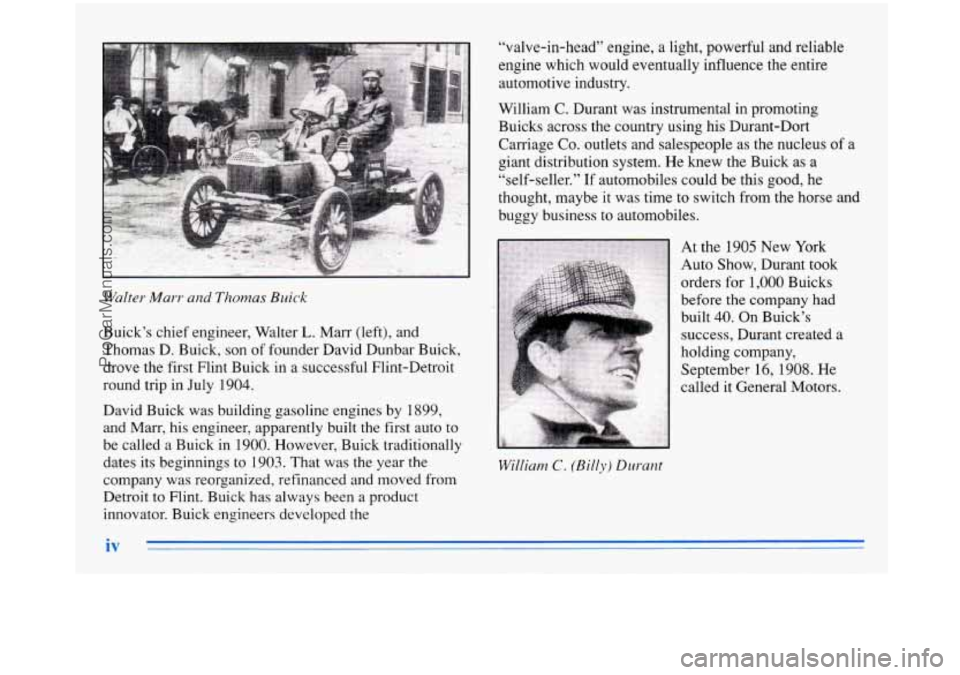
Walter Maur and Thomas Buick
Buick’s chief engineer, Walter L. Marr (left), and
Thomas D. Buick, son of founder David Dunbar Buick,
drove the first Flint Buick in a successful Flint-Detroit
round trip in July 1904.
David Buick was building gasoline engines by 1899,
and Marr, his engineer, apparently built the first auto to
be called a Buick in 1900. However, Buick traditionally
dates its beginnings to 1903. That was the year the
company was reorganized, refinanced and moved from
Detroit to Flint. Buick has always been a product
innovator. Buick engineers developed the “valve-in-head” engine, a
light, powerful and reliable
engine which would eventually influence the entire
automotive industry.
William C. Durant was instrumental in promoting
Buicks across the country using his Durant-Dort
Carriage
Co. outlets and salespeople as the nucleus or a
giant distribution system. He knew the Buick as a
“self-seller.”
If automobiles could be this good, he
thought, maybe
it was time to switch from the horse and
buggy business to automobiles.
1.
At the 1905 New York
Auto Show, Durant took
orders for 1,000 Buicks
before the company had
built
40. On Buick’s
success, Durant created
a
holding company,
September 16, 1908. He
called it General Motors.
William C. (Billy) Duvant
ProCarManuals.com
Page 22 of 388
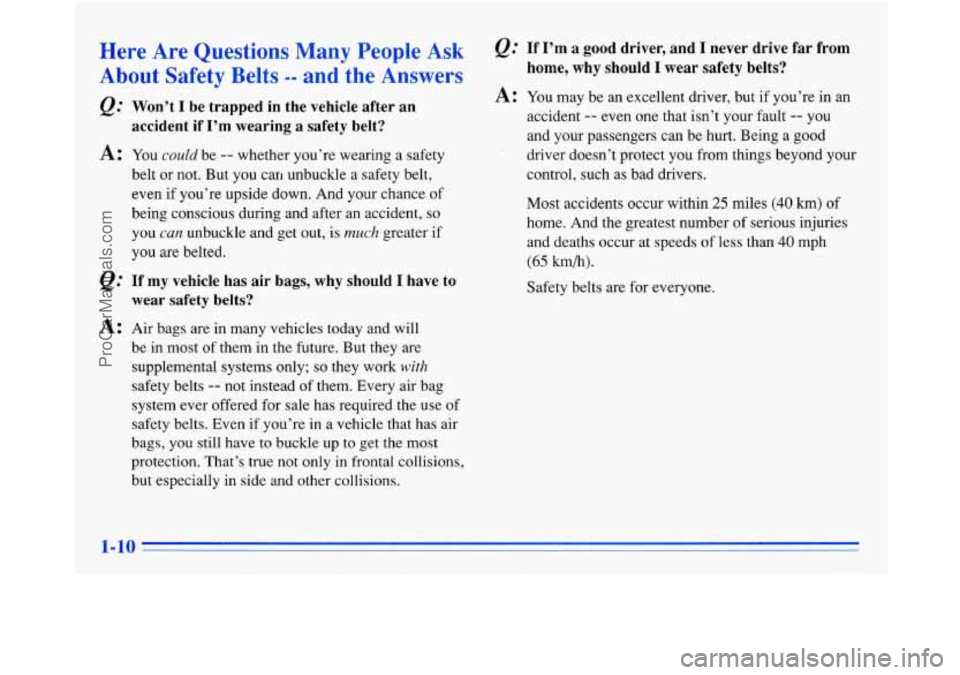
Here Are Questions Many People Ask Q: If I’m a good driver, and I never drive far from
About Safety Belts -- and the Answers home, why should I wear safety belts?
A:
Q:
A:
Won’t I be trapped in the vehicle after an
accident if I’m wearing a safety belt?
You could be -- whether you’re wearing a safety
belt or not. But you can unbuckle a safety belt,
even if you’re upside down. And your chance
of
being conscious during and after an accident, so
you can unbuckle and get out, is much greater if
you are belted.
If my vehicle has air bags, why should I have to
wear safety
belts?
Air bags are in many vehicles today and will
be in most
of them in the future. But they are
supplemental systems only;
so they work with
safety belts -- not instead of them. Every air bag
system ever offered for sale has required the use of
safety belts. Even if you’re in a vehicle
that has air
bags, you still have to buckle up
to get the most
protection. That’s true
not only in frontal collisions,
but especially in side and other collisions.
A: You may be an excellent driver, but if you’re in an
accident
-- even one that isn’t your fault -- you
and your passengers can be hurt. Being a good
driver doesn’t protect you from things beyond your
control, such as bad drivers.
Most accidents occur within
25 miles (40 km) of
home. And the greatest number of serious injuries
and deaths occur at speeds
of less than 40 mph
(65 b/h).
Safety belts are for everyone.
1-10
ProCarManuals.com
Page 59 of 388

Door Locks
Unlocked doors can be dangerous.
Passengers
-- especially children -- can easily
open the doors and
fall out. When a door is
locked, the inside handle won’t open it.
Outsiders can easily enter through an unlocked
door when you slow down or stop your vehicle.
This may not be
so obvious: You increase the
chance of being thrown out of the vehicle in
a
crash if the doors aren’t locked. Wear safety belts
properly, lock your doors, and you will be
far
better off whenever you drive your vehicle. There
are several ways
to lock and unlock your vehicle.
From the outside, use your door key or Remote Keyless
Entry,
if your vehicle has this option.
To lock the door from the
inside, slide the lock control
lever down.
To unlock the door, slide the
lock control lever up.
ProCarManuals.com
Page 71 of 388

Trunk Lid Automatic Pull-Down Feature
(Option)
If your Buick has this option, never slam the trunk lid to
close it. Instead, gently lower the trunk lid until it is
nearly shut -- the automatic pull-down will take over
and lock the trunk firmly.
A CAUTION:
Your car may have an automatic pull-down
feature that helps close the trunk electronically.
Your fingers can be trapped under the trunk lid
as it goes down. Your fingers could be injured,
and
you would need someone to help you free
them. Keep your fingers away from the trunk lid
as you close it and as it is going down.
Theft
Vehicle theft is big business, especially in some cities.
Although your Buick has a number
of theft-deterrent
features, we know that nothing we put
on it can make
it impossible to steal. However, there are ways you
can help.
I Key in the Ignition
If you leave your vehicle with the keys inside, it’s an
easy target for
joy riders or professional thieves -- so
don’t do it.
With the ignition
OFF and the driver’s door open, you’ll
hear
a chime reminding you to remove your key from
the ignition and take it with you. Always do this. Your
steering wheel will be locked, and
so will your ignition
and transaxle. And remember to lock the doors.
ProCarManuals.com
Page 100 of 388
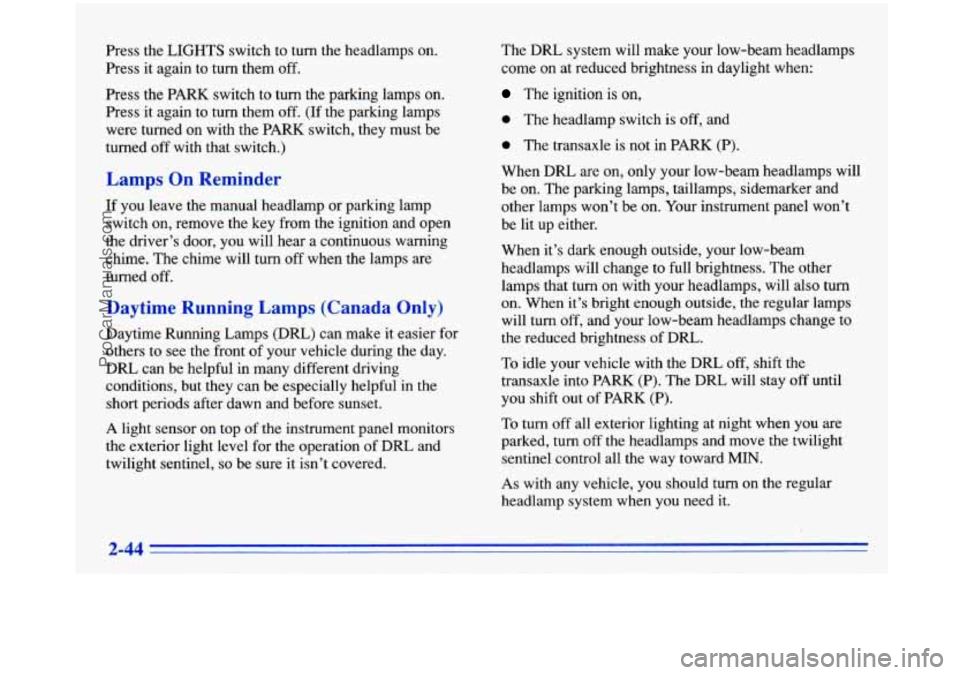
Press the LIGHTS switch to turn the headlamps on.
Press it again to turn them
off.
Press the PARK switch to turn the parking lamps on.
Press it again
to turn them off. (If the parking lamps
were turned on with the PARK switch, they must be
turned off with that switch.)
Lamps On Reminder
If you leave the manual headlamp or parking lamp
switch on, remove the key from the ignition and open
the driver’s door, you will hear a continuous warning
chime. The chime will turn
off when the lamps are
turned
off.
Daytime Running Lamps (Canada Only)
Daytime Running Lamps (DRL) can make it easier for
others to see the front of your vehicle during the day.
DRL can be’helpful in many different driving
conditions, but they can be especially helpful in the
short periods after dawn and before sunset.
A light sensor on top of the instrument panel monitors
the exterior light level
for the operation of DRL and
twilight sentinel,
so be sure it isn’t covered. The
DRL system will make your low-beam headlamps
come on at reduced brightness in daylight when:
The ignition is on,
0 The headlamp switch is off, and
0 The transaxle is not in PARK (P).
When DRL are on, only your low-beam headlamps will
be on. The parking lamps, taillamps, sidemarker and
other lamps won’t be on. Your instrument panel won’t
be lit up either.
When it’s dark enough outside, your low-beam
headlamps will change to full brightness. The other
lamps that turn on with your headlamps, will also turn
on. When it’s bright enough outside, the regular lamps
will turn
off, and your low-beam headlamps change to
the reduced brightness of
DRL.
To idle your vehicle with the DRL off, shift the
transaxle into PARK
(P). The DRL will stay off until
you shift out of PARK (P).
To turn off all exterior lighting at night when you are
parked, turn
off the headlamps and move the twilight
sentinel control all the way toward
MIN.
As with any vehicle, you should turn on the regular
headlamp system when you need it.
ProCarManuals.com
Page 170 of 388

To help avoid hearing loss or damage:
FM stereo will give you the best sound. But FM signals
will reach only about 10 to
40 miles (1 6 to 65 km). Tall
buildings or hills can interfere with FM signals, causing
the sound to come and go.
The range for most AM stations
is greater than for FM,
especially at night. The longer range, however, can
cause stations to interfere with each other. AM can pick
up noise from things like storms and power lines. Try
reducing the treble to reduce this noise if you ever get it.
AI Iudi Sy
Hearing damage from loud noise is almost undetectable
until it is too late. Your hearing can adapt to higher
volumes
of sound. Sound that seems normal can be loud
and harmful to your hearing. Take precautions by
adjusting the
volume control on your radio to a safe
sound level before your hearing adapts to
it.
0 Adjust the volume control to the lowest setting.
Increase volume slowly until you hear comfortably
and clearly.
NOTICE:
~ Before you add any sound equipment to your
vehicle
-- like a tape player, CB radio, mobile
telephone or two-way radio
-- be sure you can
add what you want.
If you can, it’s very
important to do it properly. Added sound
equipment may interfere with the operation of
your vehicle’s engine, Delco radio
or other
systems, and even damage them. Your vehicle’s
systems may interfere with the operation
of
sound equipment that has been added
improperly.
So, before adding sound equipment, check with
your dealer and be sure to check Federal rules
covering mobile radio and telephone units.
ProCarManuals.com
Page 178 of 388
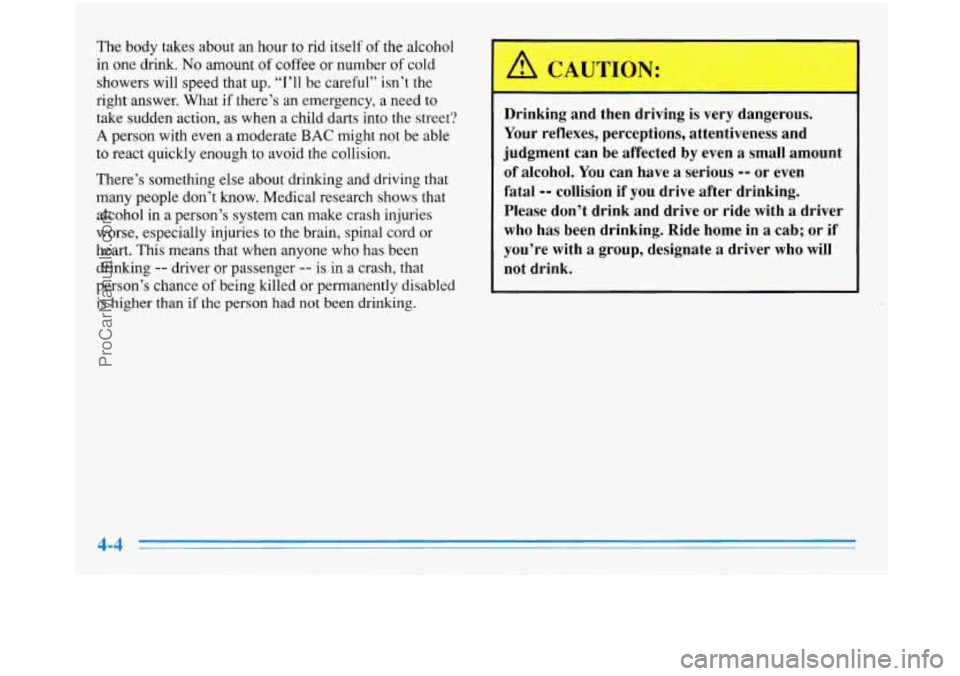
The body takes about an hour to rid itself of the alcohol
in one drink.
No amount of coffee or number of cold
showers will speed that up. ‘7’11 be careful” isn’t the
right answer. What if there’s an emergency, a need to
take sudden action, as when a child darts into the street?
A person with even a moderate BAC might not be able
to react quickly enough to avoid the collision.
There’s something else about drinking and driving that
many people don’t know. Medical research shows that
alcohol in a person’s system can make crash injuries
worse, especially injuries to the brain, spinal cord or
heart. This means that when anyone who has been
drinking
-- driver or passenger -- is in a crash, that
person’s chance of being killed or permanently disabled
is
higher than if the person had not been drinking. Drinking and then driving
is very dangerous.
Your reflexes, perceptions, attentiveness and
judgment can be affected by even
a small amount
of alcohol.
You can have a serious -- or even
fatal
-- collision if you drive after drinking.
Please don’t drink and drive or ride with a driver
who has been drinking. Ride home in
a cab; or if
you’re with
a group, designate a driver who will
not
drink.
ProCarManuals.com
Page 182 of 388
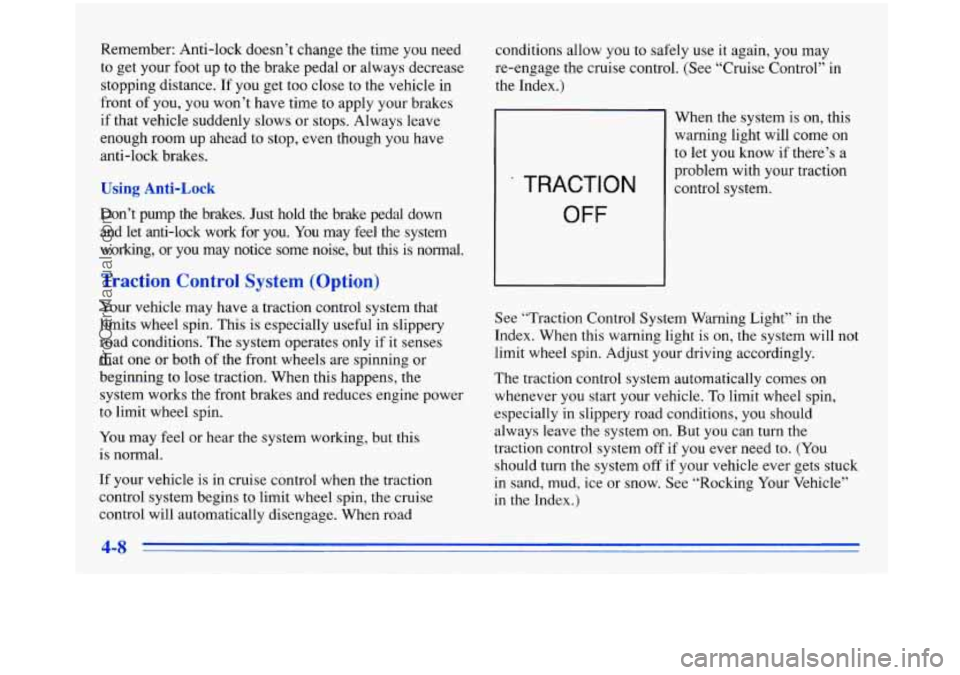
Remember: Anti-lock doesn’t change the time you need
to get your foot up to the brake pedal or always decrease
stopping distance. If
you get too close to the vehicle in
front of you, you won’t have time to apply your brakes
if that vehicle suddenly slows or stops. Always leave
enough room up ahead to stop, even though you have
anti-lock brakes.
Using Anti-Lock
Don’t pump the brakes. Just hold the brake pedal down and let anti-lock work for you. You may feel the system
working, or you may notice some noise, but this is normal.
Traction Control System (Option)
Your vehicle may have a traction control system that
limits wheel spin. This is especially useful in slippery
road conditions. The system operates only if it senses
that one or both of the front wheels are spinning or
beginning to lose traction. When this happens, the
system works the front brakes and reduces engine power
to
limit wheel spin.
You may feel or hear the system working, but this
is normal.
If your vehicle is in cruise control when the traction
control system begins to limit wheel spin,
the cruise
control will automatically disengage. When road conditions allow
you to safely use it again, you may
re-engage the cruise control. (See “Cruise Control” in
the Index.)
TRACTION
OFF
When the system is on, this
warning light will come on
to let you know if there’s a
problem with your traction
control system.
See “Traction Control System Warning Light” in the
Index. When this warning light
is on, the system will not
limit wheel spin. Adjust your driving accordingly.
The traction control system automatically comes on
whenever you start your vehicle.
To limit wheel spin,
especially in slippery road conditions, you should always leave the system on. But you can turn the
traction control system off
if you ever need to. (You
should turn the system
off if your vehicle ever gets stuck
in sand, mud, ice or snow. See “Rocking Your Vehicle”
in the Index.)
ProCarManuals.com